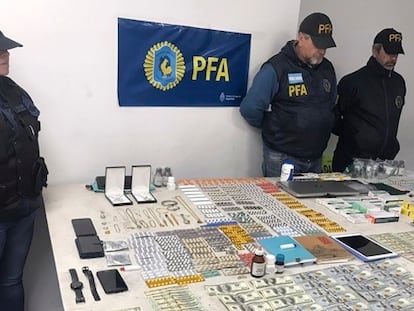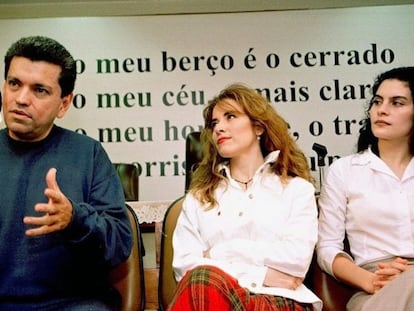From an invitation to model for private parties to victim of a prostitution ring
A married couple in Spain interviewed girls in their luxury apartment then imprisoned them in houses controlled by video surveillance to sell sexual services on the web

A young woman was dancing in a nightclub in Madrid this November when she was approached by a woman dressed from head to toe in expensive designer labels and who had obviously had cosmetic surgery. The woman told her that she was very pretty and offered her a job as a “model at private parties.” All she had to do was go to exclusive events, hang out with the guests and then leave. It seemed easy. So she accepted. It was easy money for a 16-year-old girl. They arranged to meet a few days later at a house where she was supposed to provide her services, not far from the nightclub. There, she realized something was off. When she realized that this was not what she had been sold, she managed to hide and call the police to report that she was being held hostage in a house. Officers went to the address she gave them and rescued her. They discovered that she had been abducted by a sexual exploitation network. And that she was not the only one.
In addition to this minor, there were three others who told a similar story. They had received offers in nightclubs or through social networks. Many of them had been asked to attend a kind of job interview in which their qualities as luxury escorts were assessed. For the evaluations, they were all told to go to the same place: the ringleaders’ house. It was the home of the woman who had approached the 16-year-old girl and her husband. They lived in a high-end apartment in the Tetuán district (Madrid, Spain), where rent was €3,500 ($3,769) a month and for which they had advanced four monthly payments. They paid for the apartment by sexually exploiting women, according to the police, which has arrested the couple and six other members of the scheme. Through their investigation, authorities have discovered up to 18 women enslaved by the organization that had been operating in Madrid for at least a year.
“The girls went to the houses voluntarily, thinking they were going to parties or private events. They arrived with a suitcase to stay several days and what they found was that for the first three weeks they were not allowed to leave the house,” explains Tomás Santamaría, chief inspector of the Madrid office of the Border and Immigration Force (BPEF) and the force’s human trafficking liaison. Those were the rules: three weeks. The teenager who triggered the investigation into this organization had just arrived at the house, so they had not yet taken her cell phone and that is the reason why she was able to call for help.
From the moment the girls set foot in the houses, they became part of an online catalog in which they were offered as a product. “College girl,” “silky skin,” “affectionate,” “24-hour alcohol.” The person who managed the appointments was the woman who recruited the girls in nightclubs. “She would receive calls from clients on one number and then pass on what she had agreed with them to her employees on another phone,” Santamaría said. It could be a “minimum service” of €60 ($64.62) for sex or the complete package with what they considered the best girls — especially two of them — in a house call for more or less time and with drugs included. “The one I’ve got now has bought an hour with the girl and candy (cocaine),” the woman is heard saying in a wiretap. The offer could be customized as much as the customer wanted. “There were some who called [for services] three or four times a week,” notes the chief inspector.
At the beginning, the girls, all very young, received 50% of what the men paid — an amount that decreased with different excuses. Many of them were trapped in the network because the suspects threatened them with an alleged debt they had accumulated and also with being reported, as some of them were in Spain undocumented. One of them had been taken from the Mediterranean coast and trafficked to Madrid.
This case is a clear example of the new trends of sexual exploitation in Spain. “The criminal networks have left public places and recruitment is now done through the networks themselves, and these organizations need far fewer members to control the girls,” Santamaría sums up. The transfer of this kind of slavery to private homes makes the work of investigators extremely difficult, as they have to gather evidence for months to get permission from judges to enter and search private property. “This is not like 20 years ago, with operations where we were arresting 100 people. There were those who watched the girls in the street, other security guards who prevented other gangs from entering their territory, people who moved the girls, and those who kept the accounts. Now, with one person on each floor, they have everything under control,” explains the chief inspector.
From their luxury home, the Venezuelan couple at the top of the organization supervised the houses. Thanks to video surveillance systems purchased over the internet for just €30 ($32.32), the couple had a 24-hour view of what was going on in each of their houses. “They watched the women when they came in, when they left, how long they spent with each man, and if there was anyone staying longer than the time he’d paid for,” the officer notes. Agents have found that the more trust the victim develops with her client, the more likely the exploited woman is to ask for help to get out of the situation. It is not uncommon for clients themselves to report the exploitation of a victim to the police.
The couple hardly ever stopped by the houses, except to collect money from time to time or to replenish the store of narcotics paid for by the men who contacted the organization. The group controlled five apartments: a villa in Arturo Soria, three houses in Tetuán and an apartment in Puente de Vallecas (Madrid). Between them, they got around in their BMW X6, a vehicle valued at €100,000 ($177,770), when they were not on vacation in exclusive destinations or dining in expensive restaurants. A life of luxury supported by a network of exploitation.
Sign up for our weekly newsletter to get more English-language news coverage from EL PAÍS USA Edition
Tu suscripción se está usando en otro dispositivo
¿Quieres añadir otro usuario a tu suscripción?
Si continúas leyendo en este dispositivo, no se podrá leer en el otro.
FlechaTu suscripción se está usando en otro dispositivo y solo puedes acceder a EL PAÍS desde un dispositivo a la vez.
Si quieres compartir tu cuenta, cambia tu suscripción a la modalidad Premium, así podrás añadir otro usuario. Cada uno accederá con su propia cuenta de email, lo que os permitirá personalizar vuestra experiencia en EL PAÍS.
¿Tienes una suscripción de empresa? Accede aquí para contratar más cuentas.
En el caso de no saber quién está usando tu cuenta, te recomendamos cambiar tu contraseña aquí.
Si decides continuar compartiendo tu cuenta, este mensaje se mostrará en tu dispositivo y en el de la otra persona que está usando tu cuenta de forma indefinida, afectando a tu experiencia de lectura. Puedes consultar aquí los términos y condiciones de la suscripción digital.
More information
Archived In
Últimas noticias
The metaverse, four years later: Is it finished or just at a standstill?
$3,000 and a plane ticket: The United States increases incentives for migrants to self-deport before the end of the year
Charles Dubouloz, mountaineering star, retires at 36 with a farewell tour inspired by Walter Bonatti
From the White House to diplomatic gifts: Lego wins over adult fans, brick by brick
Most viewed
- The low-cost creative revolution: How technology is making art accessible to everyone
- Families demand repatriation of bodies of Colombians who died in Ukraine: ‘This war is a slaughterhouse for foreigners’
- Christian Louboutin: ‘Young people don’t want to be like their parents. And if their parents wear sneakers, they’re going to look for something else’
- All the effects of gentrification in one corner of Mexico’s Colonia Roma
- Christmas loses its festive spirit: ICE fears cast shadow over religious celebrations











































